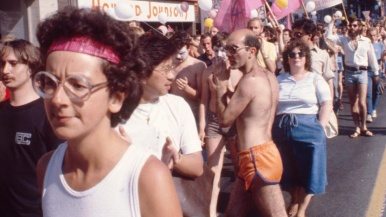The 10 biggest moments in Toronto restaurants in the last 50 years
To celebrate Toronto Life’s 50th year, we’re counting down the biggest Toronto moments of the last half-century. This month: a ranking of the openings, chefs and dishes that mattered most. Disagree with our choice for number one? Have your say at the bottom

THE BIRTH OF DEMOCRATIC DINING 2008
The Black Hoof’s no-reservations policy
10 The Hoof initiated the charcuterie craze—the prevailing food trend of 2009—but its more lasting effect was the democratization of dining. As owner Jen Agg and chef Grant van Gameren decreed, no one got a reservation, no matter how famous. Potty-mouthed TV star Gordon Ramsay, globe-trotting gourmand Anthony Bourdain and Michelin-starred chef Daniel Boulud were all told to get in line. The policy was loved or loathed—no middle ground—and spread to Pizzeria Libretto, Guu (now Kinka Izakaya), Local Kitchen, Grand Electric and beyond.

THE POWER OF THE FRENCH FRY 1994
Jamie Kennedy brings ethical eating to the masses
9 While running the kitchen at Scaramouche, Jamie Kennedy grew disenchanted with the prevalence of factory farming in Ontario. He became a champion of organic, local ingredients and opened an eponymous restaurant in the ROM, where he churned out 340 kilograms of his trademark french fries a week—tossed in sea salt and thyme, and served with chili mayo.

MOMOFUKU’S BIG BUILD 2012
David Chang’s gamble makes Toronto an expansion destination
8 The arrival of David Chang’s superlative ramen was cause for celebration. The symbolism of his arrival was even more important. When New York super-chefs think expansion, they tend to head to Las Vegas first. Chang, intrigued by Toronto’s culinary sophistication and vibrancy, bought in big time. He built a 6,600-square-foot, three-restaurant-plus-bar emporium at the foot of the Shangri-La. A wave of foreigners followed, including Daniel Boulud at the Four Seasons, Scott Conant at the Thompson and Jamie Oliver in Yorkdale.

EATING OUTSIDE BECOMES A THING MID-’60s
When patios were considered scandalous
7 Torontonians were aghast when Martha von Heczey, owner of the Coffee Mill café, applied for a patio licence. What kind of self-respecting diner would eat outdoors? She forged ahead anyway, and gradually, customers warmed, then flocked, to the idea. By the mid-’60s, the Coffee Mill patio had become a retreat for artists like Margaret Atwood, Leonard Cohen and Carol Shields.

FRANCO PREVEDELLO WOWS WITH CENTRO 1987
The launch pad for a generation of star chefs
6 Since 1970, Franco Prevedello has owned, managed or consulted at 24 restaurants, earning him a reputation as the godfather of Toronto fine dining. His greatest venue was Centro, the uptown institution he opened in 1987. The room was elegant, the food exquisite and expensive. Throughout the ’90s, it was a north Toronto favourite, and its kitchen was a training ground for a generation of the city’s most talented chefs, including Chris McDonald, Marc Thuet and Michael Bonacini.

PREGO VERSUS BISTRO 990 1990s
TIFF hot spots battle for gawking supremacy
5 After Bemelmans closed in 1994, the gawking set decamped to Prego della Piazza and Bistro 990, a pair of Yorkville refuges for famous types—thanks to their no-camera policies. During TIFF, Denzel Washington, Sean Connery, Sharon Stone, Liam Neeson and Michael Douglas were regulars at Bistro 990; Johnny Depp and Paris Hilton were Prego types.

NO MORE SHRIMP COCKTAIL! 1966
Three Small Rooms nixes menu faves
4 When opening his new restaurant at the Windsor Arms, hotelier George Minden instructed his chef to keep prime rib and shrimp cocktail off the menu—the culinary equivalent of blasphemy in a city that considered both must-haves. Initially, the masses revolted (“Peasants Beware!” read the first review), but they soon came around to sumptuous alternatives, including one called hors d’oeuvres riche: foie gras, caviar and smoked sturgeon. Three Small Rooms became the proto-foodie epicentre, and its success gave chefs licence to experiment.

THE LOCAVORE PIONEER 1993
Stadtländer opens Eigensinn Farm
3 Michael Stadtländer seemed groomed for conventional culinary fame: he co-ran Scaramouche in the early ’80s, opened a restaurant downtown and later won critics’ favour at his tasting-menu spot Nekah. Then, in 1993, he gave it all up to open Eigensinn Farm, a 12-seat establishment in sleepy Singhampton. Virtually every ingredient he serves is foraged, grown, bred or slaughtered on-site, putting him roughly a decade ahead of the locavore curve. The place continues to have a months-long waiting list.

THE BIRTH OF BEMELMANS 1977
The original high-society hot spot
2 In 1977, TIFF was a year old, Ontario’s antiquated liquor laws finally allowed patrons to drink whilst in the act of standing, and stories of N.Y.C.’s Studio 54 abounded. A retired football player named Tom Kristenbrun decided to outfit a former Yorkville fast food joint with a regal black-and-gold gate, tin ceilings and $25,000 in funky art. Bemelmans quickly became the haunt of media bigwigs like Conrad Black, Garth Drabinsky and Peter Newman, visiting celebs like Ted Danson, Eartha Kitt and Mel Gibson, and society names like Barbara Amiel, Nan Kempner and Rosemary Sexton.

THE FIRST CELEBRITY CHEF 2000
Coleslaw would never be the same
1 Torontonians knew all about Susur Lee—he had dazzled at Lotus for a decade—but it was Susur, his fine-dining follow-up, that made him an international name. Diners reserved months in advance to taste his risotto paired with exotic fruit, duck magret with Chinese haw berries and the insta-famous Singapore slaw. Restaurant magazine named Susur one of the world’s 50 best restaurants of 2002. A string of TV appearances followed—the pinnacle: Iron Chef—plus an N.Y.C. restaurant that wasn’t so hot. Today, any Canadian chef deemed a “star” owes a debt of gratitude to Lee, the genuine article.













